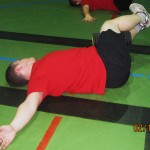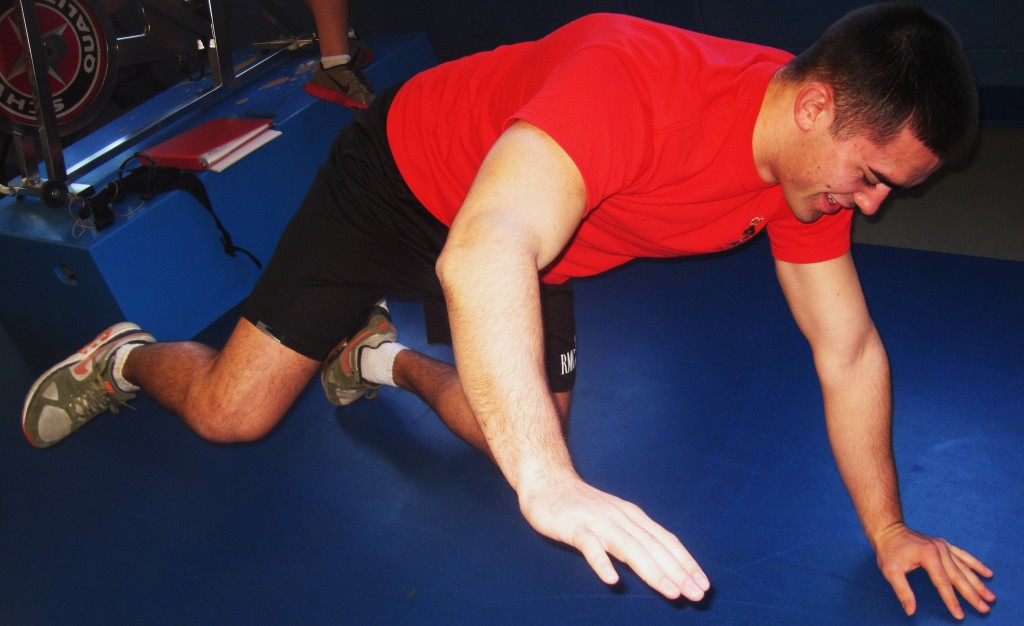
Functional Movement Screen Brings “Very Positive” Results
Article by Erin Thompson, Supplementary Physical Training Coordinator and Physical Educator in the RMC Athletic Department.
In summer of 2011, Physical Education teachers Kara Mazerolle (Collective Sports Coordinator) and Erin Thompson (Supplementary Physical Training (SPT) Coordinator) were certified through Functional Movement Systems Level 1 and 2. (http://www.functionalmovement.com/)
The Functional Movement Screen was a proven predictor of recruit success in the United States Military in 2010 (Raliegh et al.). The purpose of the screen is to prevent micro-traumatic injuries and improve performance. The Screen looks at 7 movement patterns and scores an individual from 0 = pain during movement to 3 = perfect movement pattern with no compensations.
 The functional movement assessment identifies or “zeros in on” what the individual’s specific weakness or asymmetries are. These are mobility, stability, or flexibility issues. From this point, the evaluator is able to draw from a library of exercises provided by Functional Movement Systems and prescribe specific exercises for performance improvement, pain reduction, and injury prevention.
The functional movement assessment identifies or “zeros in on” what the individual’s specific weakness or asymmetries are. These are mobility, stability, or flexibility issues. From this point, the evaluator is able to draw from a library of exercises provided by Functional Movement Systems and prescribe specific exercises for performance improvement, pain reduction, and injury prevention.
Once the SPT Coordinator, Erin Thompson, started to screen and assess members of SPT in September of this school year, she found the same weaknesses and asymmetries were prevalent for the most part, across the board.
The majority of her findings in the early fall 2011 were that most individuals, regardless of which component of the PPT test was failed, had one or all of the following mobility and/or stability problems; tight hamstrings, gluts, calves, or lower back muscles, one weak side for anterior (front of the body) core stability, too much muscle “tone” through one or both side’s hip flexors, thoracic spine and shoulder mobility problems, extreme immobility and instability through the posterior hip (back of the body), trunk stability issues, extremely weak rotary core stability, and for some push ups failures, good shoulder mobility, but very poor scapular stability (shoulder blades).
For those on SPT, working on having healthy body composition, engaging in regular strength and conditioning programming, and practicing PPT components are all absolutely vital for success; however, corrective exercises for the aforementioned weaknesses and imbalances have been incorporated into the daily SPT routine and the results are very positive.
Some Officer Cadets that have participated in the SPT program this fall and winter made the following comments through a questionnaire:
“The SPT program is in essence a training program, but also something of a rehabilitation program. I say this because it helps people get back into the groove of things. While it is designed to tackle a plethora of different muscle groups, some people only require specific training to one group. It is for this reason that some people might be less inclined to do it. It’s a decent program that helps tone out all components of the PPT while also building flexibility”. (1st year male)
“The SPT program did help me. It allowed me to discover the particular aspects I was having trouble in and work on them and improve them to meet the standard.” (2nd year female)
“SPT was a beneficial program. The instructors were of great help too. It was the type of program that if you put a lot of effort into it, you’ll achieve great results.”(2nd year female)
“Overall, I loved how it is this year than in previous years. There is much more flexibility with the workout plans and the OCdts have more freedom to focus on what they need (whether it be push-ups, sit-ups, etc…) There are always exercises to do and it is very hard for an OCdt to ‘slack-off’ (in some cases, this is true even if they are not giving their 110% effort).” (4th year SPT assistant)
“The SPT program was extremely beneficial for me. I failed the push up component of the PPT by a margin. At first I was skeptical, but SPT helped not only my passing the push ups two weeks after I started, but it also built flexibility and taught me many exercises that I never would have done. Now I have my own program combining my preferences with many of the components of the SPT program.”(1st year male)
The Officer Cadets that participated in this questionnaire were asked to rate the program from 0 = completely ineffective to 5 = extremely effective.
The average score collected was 4.25 / 5.
The program itself seems to be a success this year. However, certain individuals spend quite a bit of time on SPT during their career at RMC and this can be for many various reasons. To name a few, lifestyle outside of the 4 training sessions they get per week, drive, confidence, eating habits, motivation, depression, anxiety, and medical limitations.
The question that often comes up is “how can I help those in my squadron improve outside of SPT”? The answer to this is to implement squadron wide (not just limited to SPT members) health initiatives. Look for healthy choices in the mess and find ways of getting everyone on board to make healthy choices, try limiting alcohol intake as a squadron, buddy up with someone that could use a running partner or spotter at the gym and chart workout hours and time training in the residence for everyone to see. Develop a point system and maybe even offer prizes. Many people are influenced by the environment they live in, so adjusting this and fostering positive change could be very helpful for those on SPT and every Officer Cadet in the squadron.
Erin Thompson is a Physical Educator for the Athletic Department of the Royal Military College of Canada specializing in strength and conditioning. Mrs. Thompson has been with RMC for 5 years. Since joining the Athletic Department Erin has been instrumental in developing training programs for a number of unique initiatives (including FYOP, Recruit Term, and morning Squadron PT). Her holistic approach to health and fitness has made her a perfect fit to deliver the SPT Program and meet the individualized needs of this group.


